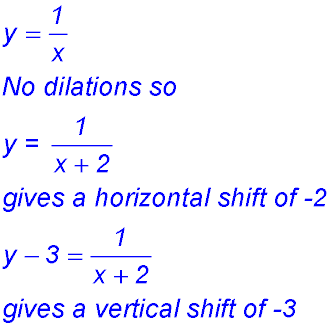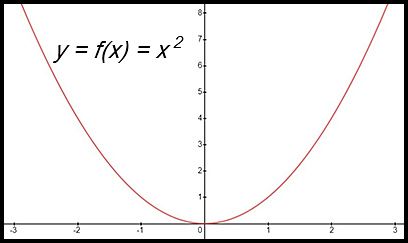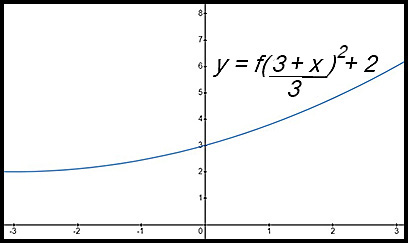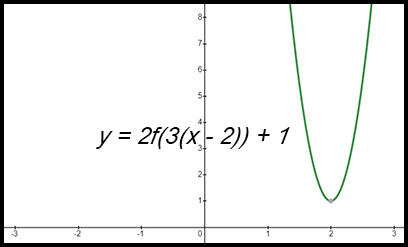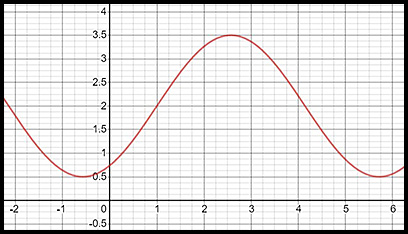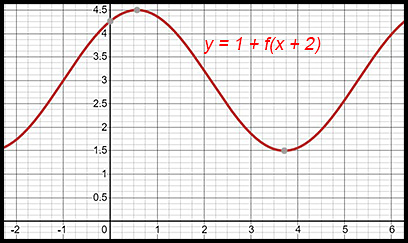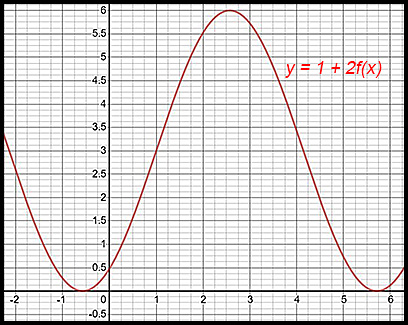Where the techniques of Maths
are explained in simple terms.
Functions - Transformations.
Test Yourself 1 - Solutions.
- Algebra & Number
- Calculus
- Financial Maths
- Functions & Quadratics
- Geometry
- Measurement
- Networks & Graphs
- Probability & Statistics
- Trigonometry
- Maths & beyond
- Index
Remember when determining SHIFTS, we need to change a given equation into the form 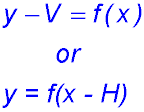
When determining DILATIONS, we need to change a given equation into the form 
Also remember that it is generally better to do the dilations before doing the shifts.
| Shift only | 1. When y = x2 is shifted 2 units left:
y = (x + 2)2 |
2. When y = x3 is shifted 3 units right:
y = (x - 3)3 |
| 3. When y = 5x is shifted 5 units down:
y + 5 = 5x or y = 5x - 5 |
4. When y = x - 5 is shifted 2 units up:
y - 2 = x - 5 or y = x - 3 |
|
| 5. Shifting 3 units to the left
changes y = 5x2 + 2 to y = 5(x + 3)2 + 2 |
6.
Shifting 0.5 units up changes
y = 2√x - 2.6 to y - 0.5 = 2√x - 2.6? So y = 2√x - 2.1. |
|
| 7. Shifting 6 units down changes
y = 5 to
y = -1. |
8. Shifting 2 units to the right changes x = -4 to x = -2. |
|
| Dilation only | 9. Dilating y = x2 vertically by a factor of 2 gives y/2 = x2 or y = 2x2. | 10. Dilating y = 2x vertically by a factor of 1/3 gives 3y = 2x (after dividing y by 1/3). |
11. Dilating  . . |
12. Dilating
y = x2 horizontally by a factor of 0.5 gives
|
|
| 13. The original parabola has x intercepts at x = -2 and x = 1 and a vertex at (-0.5, -2.25). Dilating y = (x - 1)(x + 2) horizontally by a factor of 3 (i.e. expanding or dilating it horizontally) but no shift requires dividing the x terms in BOTH bracketed terms by 3:
So both the vertex and the x intercepts are dilated - i.e. multiplied by 3 - so the x intercepts change to x = -6 and x = 3 (i.e. the original values are multiplied by 3) and the new vertex is at(-1.5, -2.25). |
14. Dilating
y = (x - 1)(x + 2) vertically by a factor of 3 gives
Hence the x intercepts remain at x = -2 and x = 1. The x value for the vertex remains at The parabola rises three times as fast as previously. |
|
| Identify the shift | 15. To track the change of y = 2x2 + 1 to y = 2x2 - 3 we rewrite to isolate the original equation: y = (2x2 + 1) - 4. ∴ y + 4 = (2x2 + 1) So there is a vertical shift of -4. All y values are reduced by 4. |
16. To track the change of y = 4x3 to y = 4 (x + 2)3, no rewriting is necessary as it is in the relevant format. There is a horizontal shift of -2. For example the x intercept changes from
|
| 17. To change y = x2 + y2 to
y = (x + 1)2 + (y - 2)2 there is a horizontal shift of -1 and a vertical shift of 2. |
18. To change y = sin x to y = sin (x - π) requires a horizontal shift of π units to the right. |
|
| Identify the dilation | 19. To transform y = 2x2 to y = 4x2, rewrite as y = 4x2 = 2(2x2).
Hence the effect is a vertical dilation of 2 which stretches all y values by a factor of 2 (i.e. multiplies all y values by 2). |
20. To transform
y = 3 cos x to y = cos x:
The effect of this transformation is to reduce all y values by one third. So the x intercepts remain the same but the maximum values reduce from 3 to 1. |
| 21. To transform y = 2x to y = 2x+2:
The effect of the vertical dilation is to change all y values by a dilation factor of 4 (i.e. to multiply all y values by 4 - see especially x = 0).
|
22. To transform
y = 2x + 4 to y = x + 2:
The effect of the vertical dilation is to halve all y values for each x value. Hence the point (2, 8) on y = 2x + 4 becomes (2, 4) on y = x + 2.
|
|
| Shift and dilation | 23. To change x2 + y2 = 4 into (x - 3)2 + (y + 4)2 = 16:
The centre of the original circle is (0, 0). The dilation transformations change the radius from 2 to 4. The shift transformations move the centre from |
24. The transformation(s) to change x2 + y2 = 1 into  require rewriting the equation as: require rewriting the equation as:
The circle turns into a horizontal ellipse.
|
| 25. To transform y = cos x into
y = 5cos(2x - π/3):
So the transformations are:
|
26. To transform the equation  : :
Start with the vertical dilation:
So the transformations are:
The peak of the semi-circle is at (0, 1):
|
|
| 27. To transform the equation
to become It is possible to start transforming the original equation by incorporating the vertical shift:
Hence:
Note in the above graph:
|
28. Starting with the equation
what transformations change the equation to
Transformations are:
|
|
| Use the following diagram of y = f(x) = x2 to sketch new graphs in response to the information given in each of questions 29-30.
|
||
29. 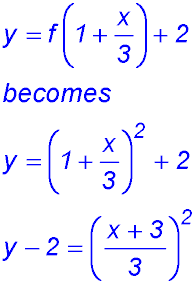
Note: There is a horizontal shift of 3 to the left and a horizontal dilution (expansion) by a factor of 3 (so the curve flattens out). Hence the parabola flattens and the vertex moves to x = -3. There is a vertical shift of 2. Hence the vertex is now at (-3, 2) rather than (0, 0). At x = 0, y = 1 + 2 = 3. |
30. 
Note: there is a horizontal shift of 2 to the right (so the vertex is now at x = 2) and a horizontal dilution of 1/3 (hence the curve becomes narrower). There is a vertical shift of 1 upwards (so the vertex moves to y = 1) and a vertical dilution by a factor of 2 (hence the curve climbs more quickly). |
|
| Use the following diagram of y = f(x) to sketch new graphs in response to the information given in each of questions 31-34.
|
||
| Diagrams | 31. 
Note: The horizontal shift of -1 moves the previous point at x = 1 to the left and it is now on the y axis. The minimum points at about x = -0.5 and x = 5.75 have moved left to about x = -1.5 and to about There is no vertical change. |
32. Note: The previous centre of the loops was at The horizontal shift of -2 moves the maximum point from about x = 2.5 to the left to x = 0.5. The next minimum at about 3.5 has therefore been shifted left to about 1.5. |
33. 
Note: The previous centre of the loops was at about The vertical shift of 1 moves the centre between the peaks and troughs from y = 2 to y = 3. The vertical dilation of 2 changes one minimum value to y = 0 at x = -0.5 and one maximum value to y = 6 at x = 2.5 respectively (a difference of 6 which is twice the original amplitude). There is no horizontal shift or dilation. |
34. 
Note: There is a horizontal dilation of ½ which compresses the pattern. Previously one of the lowest points occurred at x = ½ whereas now, the corresponding lowest point is at x = ¼. The distances between the two troughs was originally 6 units but is now 3 units. The distance above the y axis was originally ½ but it is now 1. The vertical dilation of a factor of 2 increases the amplitude of thepattern from 3 units to 6 units. |
|

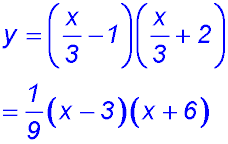
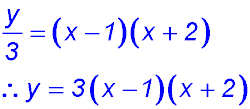
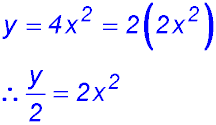

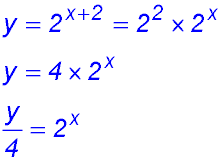
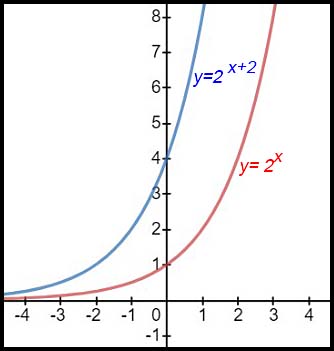


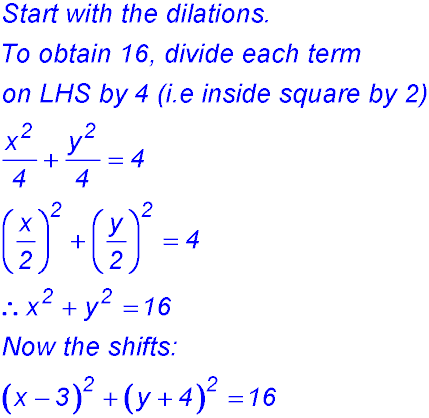
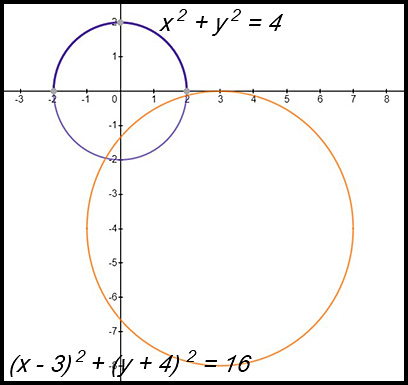

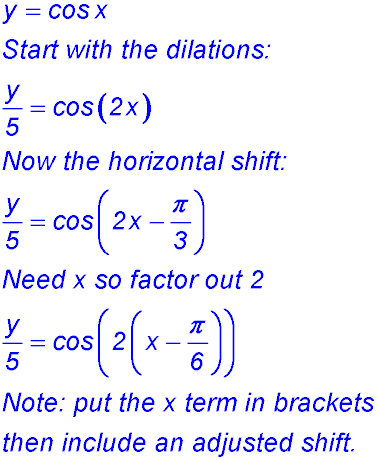
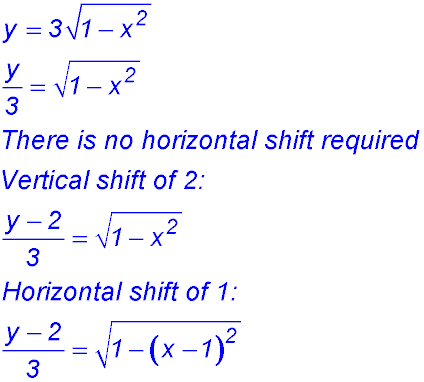
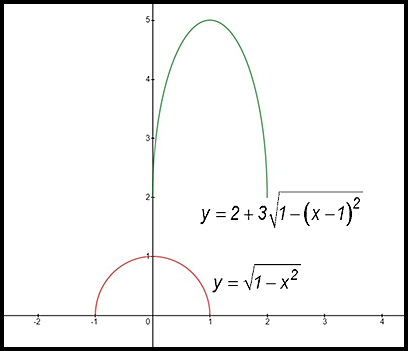
 :
: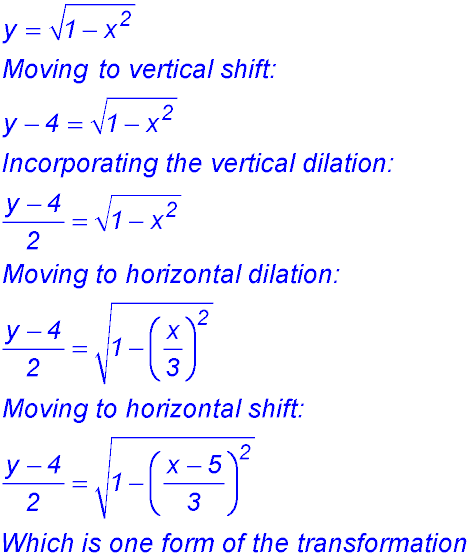


 ?
?